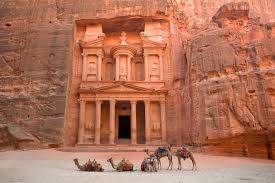Petra, Jordan
🏜️ Petra, Jordan – The Rose-Red City Lost in Time
Overview:
Tucked away in the arid mountains of southern Jordan, Petra is an archaeological marvel and a UNESCO World Heritage Site. Often referred to as the “Rose City” due to the color of the sandstone cliffs, Petra was once a thriving capital of the Nabataean Kingdom. Its intricate rock-cut architecture, especially the famed Treasury (Al-Khazneh), attracts millions of visitors a year. Rich in history and mystery, Petra feels like stepping into another world—where desert winds echo through ancient tombs, temples, and hidden passageways.
🌟 Top Attractions in Petra
🏛️ The Treasury (Al-Khazneh)
The most iconic site in Petra, the Treasury greets visitors at the end of the Siq, a narrow sandstone gorge. Carved directly into the cliff, its towering façade stands almost 40 meters tall. It likely served as a mausoleum or royal tomb, but its mysterious name stems from legends of hidden treasure.
🌄 The Siq
Your journey into Petra begins with a 1.2 km winding canyon framed by sheer cliffs rising up to 80 meters. Walking through the Siq is an experience in itself—cool, shadowed, and filled with anticipation until you catch your first glimpse of the Treasury.
🏰 The Monastery (Ad Deir)
A massive structure similar in style to the Treasury but even larger. The Monastery requires a climb of over 800 rock-cut steps, but the view at the top—and the structure itself—make the effort worthwhile. It’s quieter than the Treasury and offers breathtaking mountain views.
🏺 The Royal Tombs
This row of ornate burial sites—Urn Tomb, Silk Tomb, Corinthian Tomb, and Palace Tomb—reflects the grandeur of Nabataean funerary architecture. Located on the eastern cliffs, these tombs overlook the ancient city.
🧱 The Great Temple and Colonnaded Street
This complex includes remains of an ancient marketplace, public baths, and temples. It reflects the influence of Greco-Roman architecture, offering a glimpse into Petra’s cosmopolitan past.
🏔️ High Place of Sacrifice
An ancient altar perched atop a mountain ridge. This is one of the best viewpoints in Petra and a site believed to have been used for religious rituals. The hike is steep but lined with hidden tombs and panoramic vistas.
🍽️ Local Cuisine & Dining Near Petra
After a long day of exploring, indulge in hearty Jordanian cuisine:
-
Mansaf: Jordan’s national dish made with lamb cooked in fermented yogurt sauce, served over rice and flatbread.
-
Zarb: Bedouin-style BBQ cooked in an underground oven—tender meat, potatoes, and rice with spices.
-
Mezze Platters: Hummus, baba ghanoush, tabbouleh, olives, and falafel.
-
Try dining in Wadi Musa, the modern town near Petra, at restaurants like Al-Wadi Restaurant or My Mom's Recipe for authentic flavors.
🏨 Where to Stay in Petra
Petra offers everything from luxury hotels to budget-friendly guesthouses:
-
Mövenpick Resort Petra – A 5-star option located right next to the Petra Visitor Center.
-
Petra Moon Hotel – Great mid-range option with rooftop views and close proximity to the entrance.
-
Seven Wonders Bedouin Camp – For a more authentic desert experience, this offers tented stays and home-cooked meals in nearby Little Petra.
📆 Best Time to Visit Petra
-
Spring (March to May) and Autumn (September to November) offer ideal weather—pleasant temperatures and sunny days.
-
Avoid the summer months (June–August) due to intense heat, and winter can be surprisingly cold.
🏮 Petra by Night
For a magical experience, attend Petra by Night, held three evenings a week. The Siq and Treasury are lit by 1,500 candles, and traditional Bedouin music adds to the enchantment. It’s a truly ethereal atmosphere and perfect for photographers.
🧳 Travel Tips for Petra
-
Start early: Enter Petra as soon as the gates open to avoid crowds and harsh sun.
-
Wear sturdy shoes: You’ll be walking a lot on uneven terrain.
-
Hydration: Bring a reusable water bottle—shops and rest stops are scattered throughout the site.
-
Tickets: A one-day ticket costs around 50 JD (~$70), but a two or three-day pass is more economical if you plan to explore deeply.
-
Local guides: Hiring a local guide enriches the experience and helps support the community.


